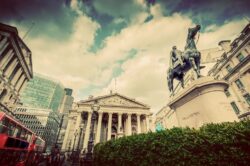Economists used to believe high unemployment and inflation were an impossible combination. Shortly before just that combination happened in the mid-70s, of course.
Not to be outdone by reality, economists stuck with their theories. They’re the basis of modern central banking, which we’ll get back to that in a moment.
Stagflation – a combination of a stagnant economy and inflation – is the ultimate fear of a central banker. Because it exposes them to be astrologers instead of astronomers.
The Bank of England is supposed to manage a trade-off between inflation and economic growth which leads to jobs. What’s known as the Phillips curve describes this trade-off.
What do I mean by trade-off? It’s probably the most important lesson of economics. You can’t have your cake and eat it. Reality is about choices between things.
The Phillips curve describes the choice between low inflation and low unemployment. A false choice, but it’s important to understand what economists believe before exposing how it’s wrong. That’s how investors can derive an advantage.
So, let’s dig into the pseudoscience of central banking for a moment.
The unemployed versus inflation
When unemployment is low, lots of people spend lots of money and that pushes up consumer prices. But too much inflation is bad, so central bankers have to rein in the economy if that happens. At the expense of jobs.
When unemployment is high, people spend less and so inflation goes down. But unemployment is bad, so central bankers have to spur on the economy. At the expense of lower inflation.
Just as astronomers have alignments of planets, central bankers have NAIRU. The non-accelerating inflation level of unemployment. It’s the sweet spot where unemployment is low enough to be a good thing, but not too low to burn Goldilocks’ inflationary lips.
But here’s the problem. What if inflation and unemployment are both high – theoretically impossible according to the Phillips curve? What do central bankers do then?
You might think they’d abandon their flawed theory and the Phillips curve. And they did after the mid-70s, when this did happen.
But only for a while.
The Quarterly economics magazine describes the zombie status of the Phillips curve best in this recent headline: “The Phillips Curve: Dead or Buried Alive?” The debate about the Phillips curve continues to this day, at the highest levels.
The reason the Phillips curve keeps coming back is because it is the bedrock of the justification of modern central banking. The idea that the central bank can keep us on the sweet spot of the Phillips curve – the NAIRU of low inflation and low unemployment – ceases to exist if the Phillips curve isn’t real in the first place. And that would expose central banks as pointless, if not a bad idea.
Central banks employ vast amounts of otherwise useless economists, so economists keep coming back to the Phillips curve. Surprise.
Doing away with central banks altogether might sound absurd. But we got rid of all other forms of government price controls over the last few decades. People used to believe they were a good idea too. For some reason, we still believe central banks manipulating the cost of borrowing is a good idea. Beats me…
Back to the question I just posed. What will central bankers do if stagflation returns?
Will they adjust their models, as our SAGE epidemiologists do? Or will they simply pretend that their policies work, as our politicians do?
Well, we may be about to find out. Because the Bank of England (BoE) sees stagflation coming.
Andrew Bailey and Uranus are in alignment
Bloomberg summarised the arcane announcement from our central bank late last week:
The BOE sees unemployment climbing to 7.7% in the second quarter, a later and higher peak then previously. Officials also cautioned inflation would rise quite sharply toward their target after the winter, they said.
They also expect an economic contraction this quarter of 2% thanks to the second lockdown. So much for the recovery…
But notice, there you have it, a sharp rise in inflation while unemployment spikes. The Phillips curve will be disproven once again.
So, what is the BoE going to do? Well, it’s just gone and done it:
The Bank of England boosted its bond-buying program by a bigger-than-expected 150 billion pounds ($195 billion) in another round of stimulus to help the economy through a second wave of coronavirus restrictions.
Governor Andrew Bailey and his colleagues voted unanimously to increase their government bond-purchase target to 875 billion pounds… Officials kept the benchmark interest rate at 0.1%.
The BoE has chosen unemployment and GDP as the priority over inflation. Despite projecting inflation to be on target in coming months, it’s continued to print more money. A huge amount more, not that anyone can really comprehend the figures any more.
Incidentally, the Germans only agreed to sign up to the euro under the explicit legal guarantee that the European Central Bank would never do this. It should focus on inflation only, not other considerations like GDP and unemployment.
And the reason central bank independence is so important is also closely related. Central banks that aren’t independent have historically made a dreadful mistake. They’ve given priority to unemployment and GDP over inflation. The very mistake we’re making now in the UK. The very mistake the Germans want to avoid ever happening again. The mistake of allowing the inflation genie out of the box.
To understand why this is such a bad mistake, I better explain my claim about why the Phillips curve is so deeply flawed.
Why the Phillips curve is no better than tarot cards
It’s quite simple. Inflation as we know it today can happen for a long list of reasons. As can deflation – falling prices.
Central bankers’ mistake is to conflate all the reasons. And simply focus on whether prices are rising or not, whatever the reason.
A shift in supply and demand moves prices. It’s a basic part of how our economy coordinates itself. What to produce and what to consume. Everyone knows that. Except central bankers, who treat the phenomenon of rising and falling prices as a problem if they happen too fast.
Technology and trade with China, for example, have reduced prices of consumer goods dramatically over time. That’s great for consumers. Unless you’re a central banker tasked with keeping inflation above 0%. Then it’s a terrible thing which must be stopped by cutting interest rates and printing money.
Inflation can also be caused by an increase in bank lending. You see, bank lending actually increases the supply of money in the economy. When you spend money on your credit card, that money is in fact created in the moment you spend it. That’s a topic we’ll explore another day.
Another cause of inflation is central bank money printing. If central banks increase the amount of money in the economy, that can cause the value of money to fall – the definition of inflation.
The problem with these different forms of inflation is that they tell you different things and are caused by different things. Some are actually good. Yet, central bankers treat them all as equally evil because they simply consider inflation to be a matter of rising consumer prices.
But the trade-off with unemployment only applies in one of the cases. The Phillips curve could hold true if the inflation is being caused by low unemployment. But it could be caused by a number of other things too.
Last but not least, there’s another flaw in the Phillips curve. One that has always bothered me deeply, but I can’t find anyone else who agrees.
When people are employed, they are employed doing something. (We’re excluding the civil service here.) This employment expands the amount of goods alongside the incomes and expenditures of those who are employed. In other words, the two cancel out, or near-abouts.
More spending comes into being alongside more stuff to spend money on. Demand and supply both grow. So there’s no reason to expect low unemployment to necessarily be inflationary. Unless people are employed but producing nothing…
If the Philips curve is false, why bother with it?
The good news in all this is that it makes the future a little more predictable for investors. We know the BoE will go on imagining the Phillips curve exists, no matter what happens. It’ll keep printing money to improve economic output and employment. Which will only lead to more inflation instead.
Sound theoretical? Consider this from James Callaghan’s Labour Party conference speech in 1976:
We used to think that you could spend your way out of a recession, and increase employment by cutting taxes and boosting Government spending. I tell you in all candour that that option no longer exists, and that in so far as it ever did exist, it only worked on each occasion since the war by injecting a bigger dose of inflation into the economy, followed by a higher level of unemployment as the next step. Higher inflation followed by higher unemployment. We have just escaped from the highest rate of inflation this country has known; we have not yet escaped from the consequences: high unemployment.
It is my firm belief that Dianne Abbott will deliver the same speech in 2024.
The mid 70s were followed by the Winter of Discontent. But don’t worry, that’s unlikely to happen this year. At least, not because of inflation and unemployment…
It takes years for these forces to play out. If they do.
Only a severe economic shock could derail a stagflationary future, in my view. About which we’ll tell you more in coming weeks.

Nick Hubble
Editor, Fortune & Freedom




